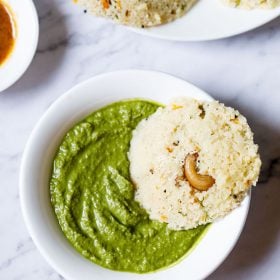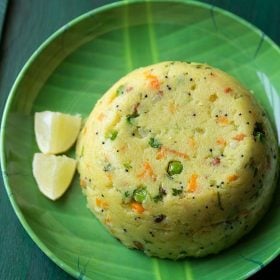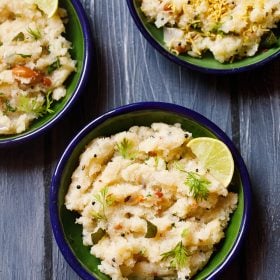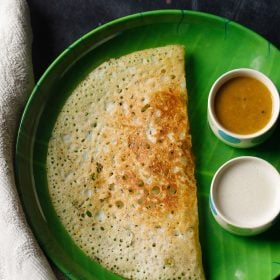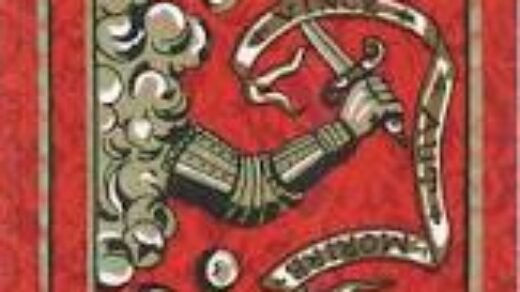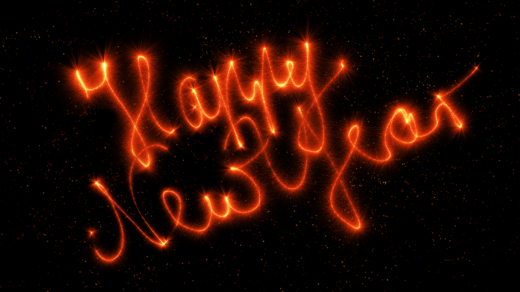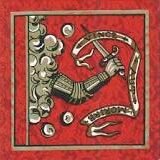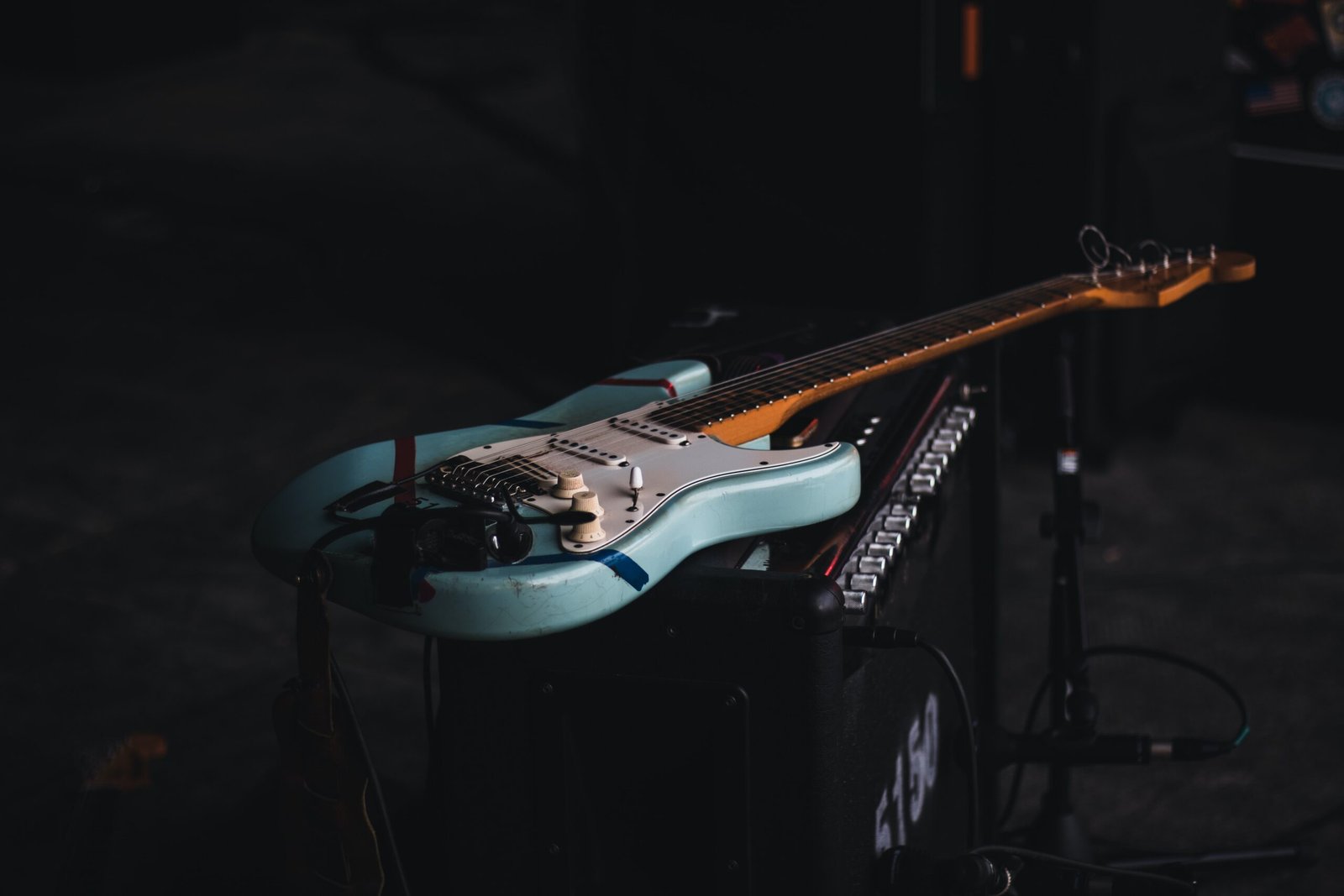Chow Chow Bath
Chow Chow Bath, despite its name suggesting Chinese origins, is actually an Indian dish hailing from Karnataka in South India. It is a popular breakfast option in Bangalore (now Bengaluru) and is served in many eateries and tiffin houses. What sets it apart is its combination of three distinct components: Khara Bath (savory), Rava Kesari (sweet), and coconut chutney. Stay tuned for a guide on how to prepare this delightful dish at home.
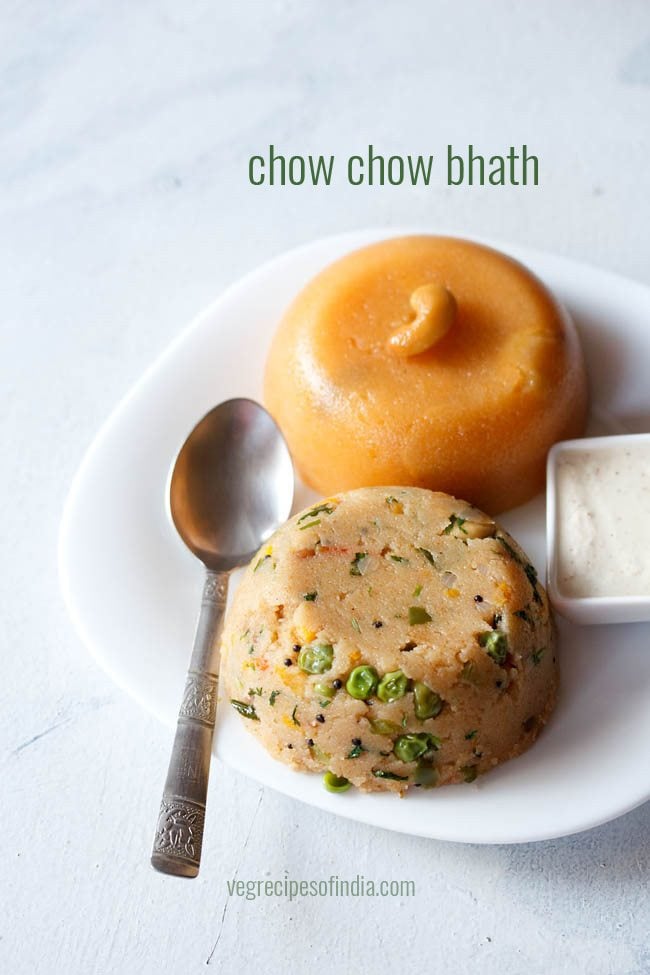

What is Chow Chow Bath
Chow Chow Bath is a classic breakfast dish from the state of Karnataka. It comprises of 2 types of kesaris and a coconut chutney. A south Indian kesari can be referred to as an equivalent to the north Indian halwa or the sheera in the western parts of India. However, the difference lies in the fact that while a halwa or sheera is primarily sweet, a kesari can also be savory.
Just like the ones that form this Chow Chow Bath. Basically, a classic Chow Chow Bath consists of a platter of a savory Khara Bath or the typical MTR style Rava Bath, a sweet Kesari Bath and a bowl of chunky coconut chutney. The rava bath is essentially a khichadi made of rava/sooji (cream of wheat/semolina) and mixed vegetables while the rava kesari is an orange or yellow colored halwa of rava/sooji and dry fruits.
The mélange of flavors from all these dishes individually, makes the Chow Chow Bath a super hit for the palate. With this recipe of mine, where I’ve demonstrated the procedure to make both these dishes, you’ll be able to try it at home without having to step out and flying to Karnataka. To make the chutney, this Coconut Chutney recipe is going to be handy.
Since the Chow Chow Bath is quite a wholesome, filling meal in itself, I usually prepare it not just for breakfasts, but as weekend brunches too. The dish is also quite appealing to eyes as well because it looks beautiful when presented in its original, authentic way.
The combination of a sweet dish along with a savory dish accompanied with a coconut chutney is just too good. However, preparing a Chow Chow Bath from start to finish is quite a time-consuming thing as it has 3 main dishes in it. So, on days, when you have some time in hand, go for this preparation.
Two common ingredients in both the recipes in this Chow Chow Bath are sooji or rava (cream of wheat) and ghee. Do use the fine variety of rava and not the coarse one. Ghee can be added less or more as per your preferences.
I prepare a very simple coconut chutney for the Chow Chow Bath, which is mentioned in the recipe card and for a detailed version, I have already shared the link too earlier in this post. I generally do not temper the chutney. But if you wish, you can temper it.
There is no particular order in which you can cook these dishes to assemble in the Chow Chow Bath. You can cook the sweet kesari bath first and then the savory rava bath or vice versa.
If you have some help in cooking, you can cook both the dishes simultaneously in two pans or kadai. But if you are doing it alone, then better cook one dish first and then move to the other.
Step-by-Step Guide
How to make Chow Chow Bath
Roasting rava
1. Heat a pan or kadai first. Add 1 cup rava or cream of wheat (fine variety).
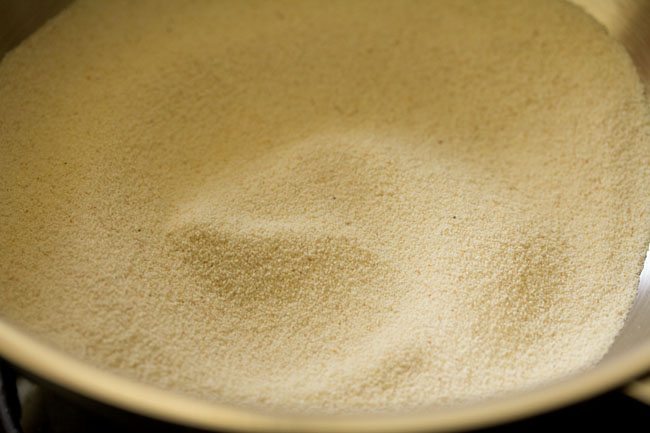

2. Begin to roast the rava. Stir often while roasting the rava. The rava or sooji grains should become fragrant and start to look dry, separate and crisp. Don’t brown the rava.
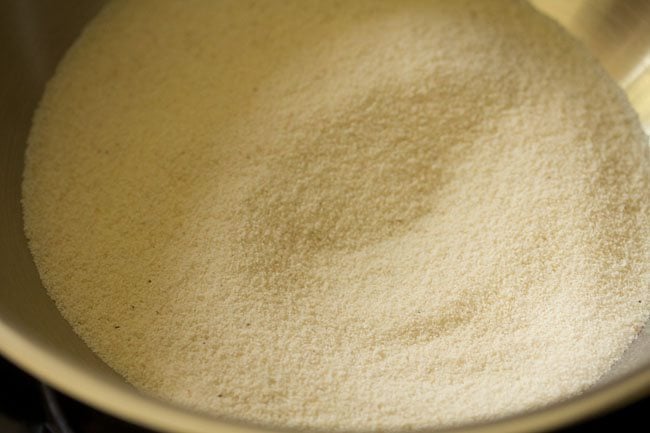

3. Roasting takes about 5 to 6 minutes on low heat. Once the rava becomes fragrant and starts to look dry and crisp, switch off the heat, add the roasted rava on a plate and keep aside.
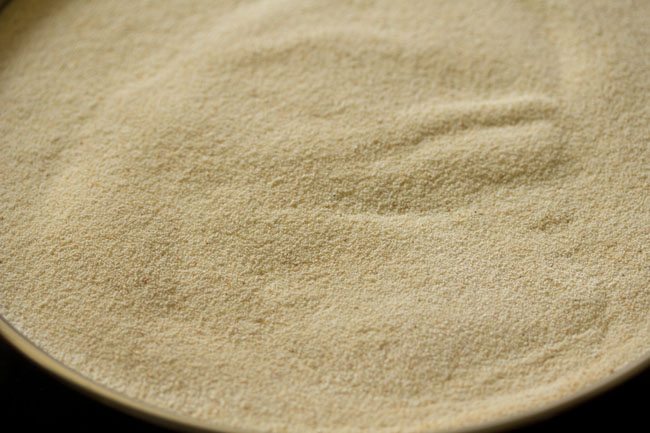

4. Take ½ cup of the roasted rava and keep aside. Half of the rava will be added in savory Khara Bath and the other half in sweet Kesari Bath.
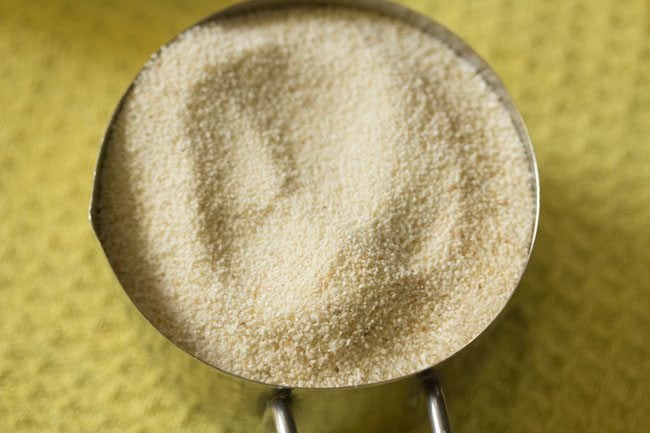

Frying cashews
5. In the same pan, heat 1 tablespoon ghee or oil.
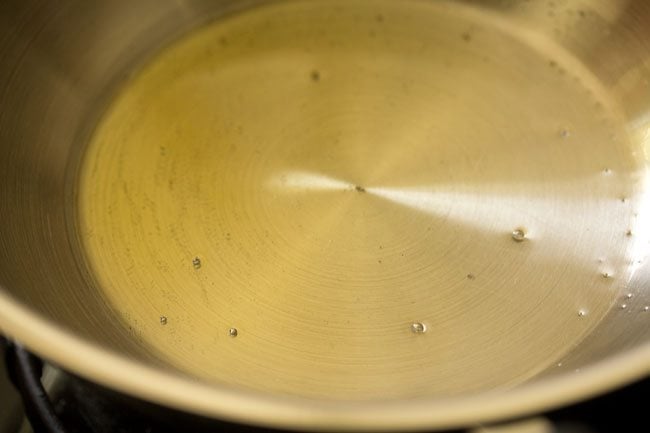

6. Add 20 to 22 cashews.
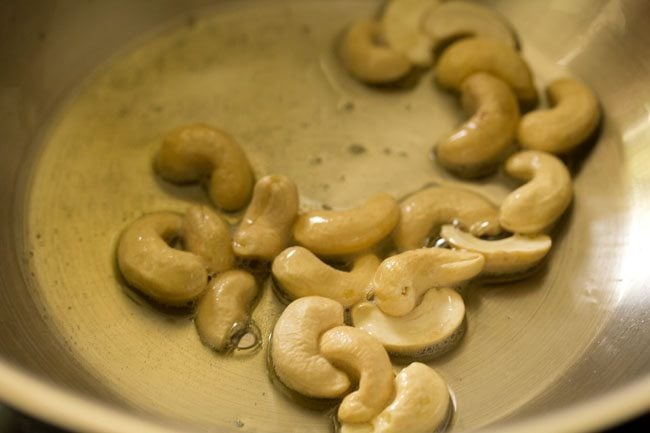

7. Stirring often, on low to medium heat, fry till the cashews turn golden. Keep aside.
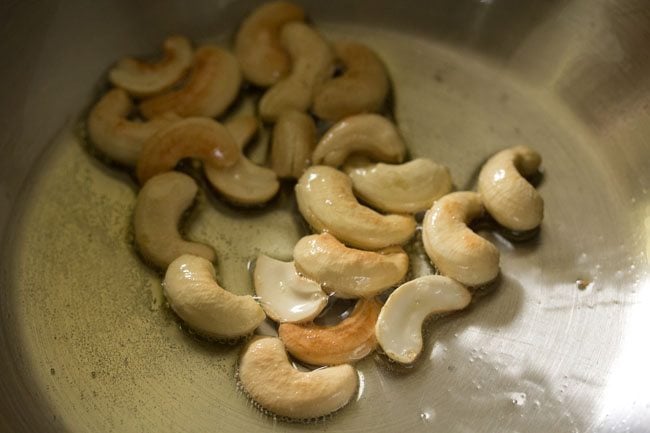

Making Khara Bath
8. Lower the heat and in the same pan, add ½ teaspoon mustard seeds, ½ teaspoon chana dal and ½ teaspoon urad dal.
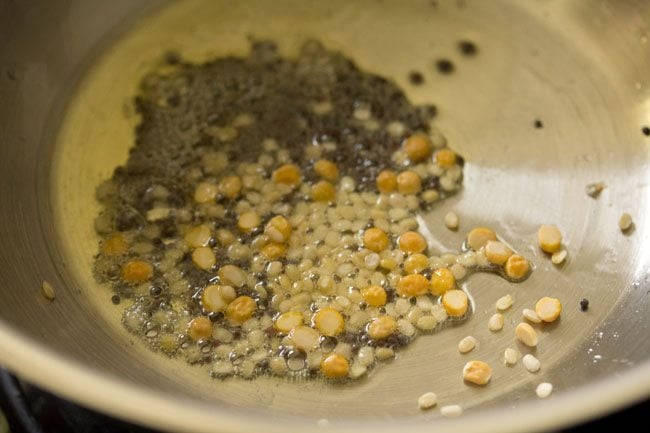

9. On low heat, sauté the dals and mustard seeds, till the dals turn golden. The mustard seeds will also crackle by then.
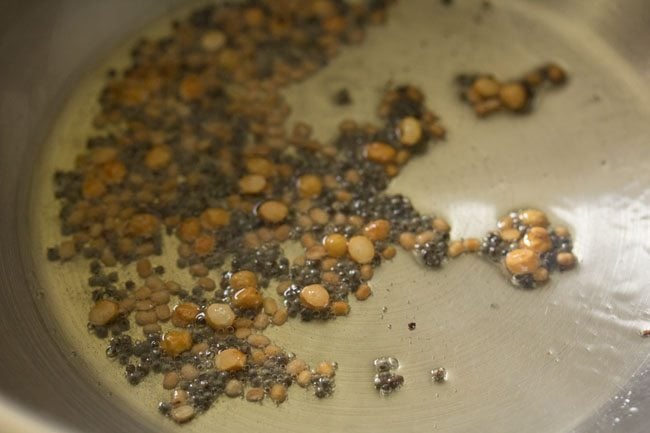

10. Next, add 3 tablespoons finely chopped onions.
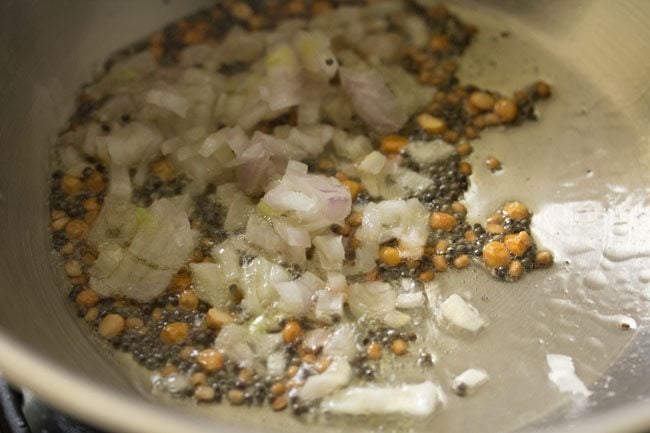

11. On low heat, sauté for a minute.
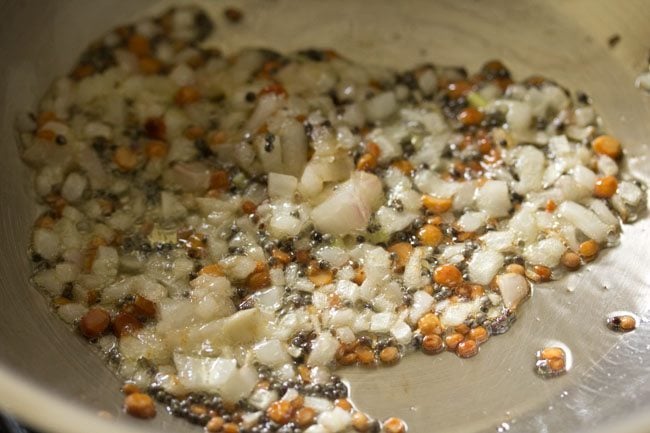

12. Then, add 3 tablespoons finely chopped capsicum, 3 tablespoons finely chopped carrot, 3 tablespoons finely chopped tomatoes and 2 tablespoons green peas.
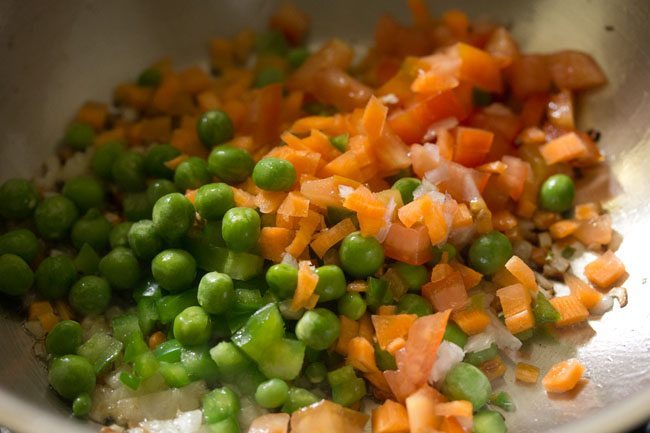

13. Mix very well and add 7 to 8 curry leaves.
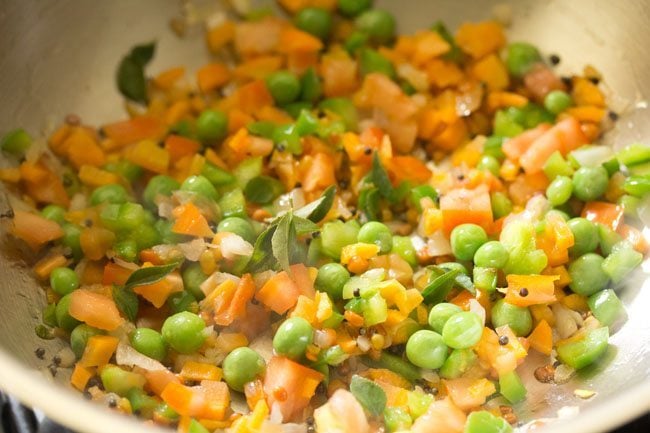

14. Season with ½ teaspoon sugar and salt as required.
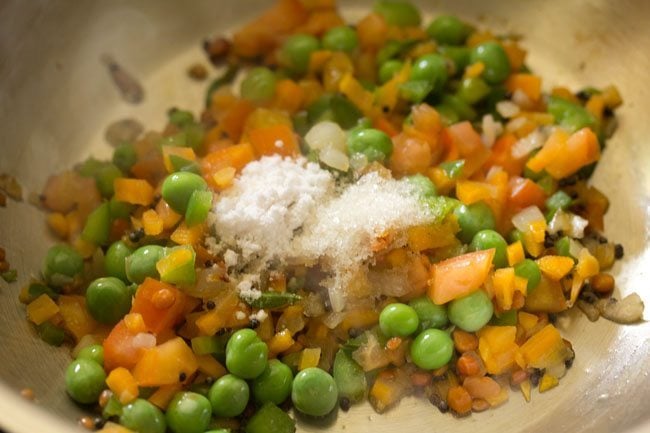

15. Then, add 1 teaspoon vangi bhaat masala. Mix very well.
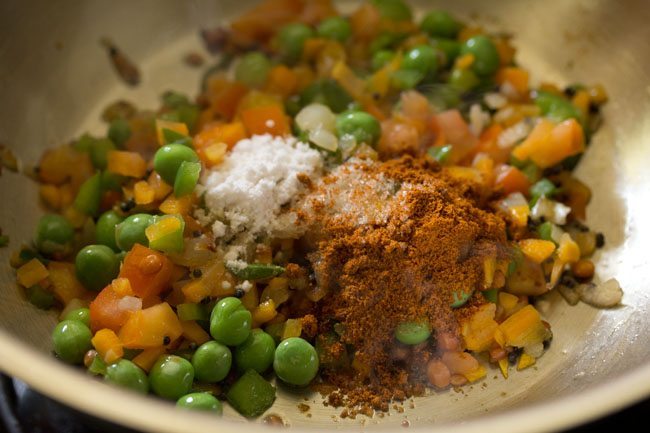

16. Now, add 1.5 cups water. Mix very well.
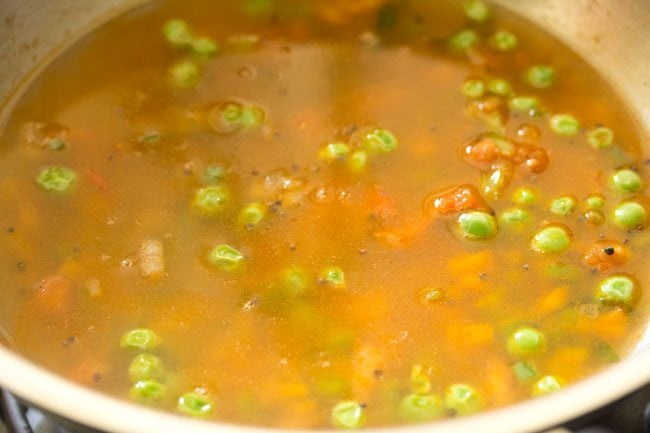

17. Bring the water to boil on medium heat.
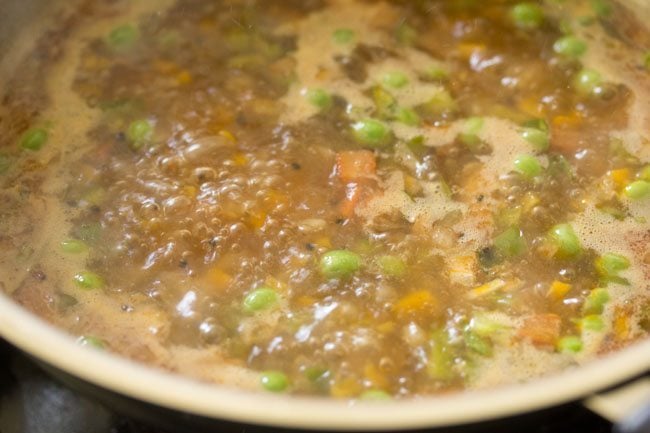

18. When the water comes to a boil, reduce heat to low and add the roasted rava in 2 to 3 batches.
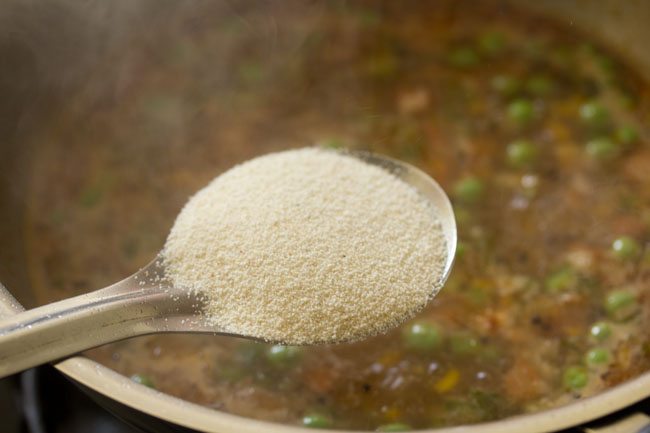

19. As soon as you add first batch, stir very well. So that lumps are not formed.
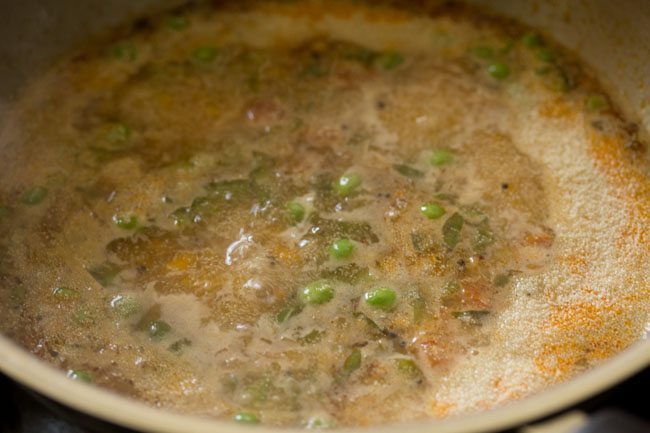

20. This way add in batches. Stir very well after adding each batch.
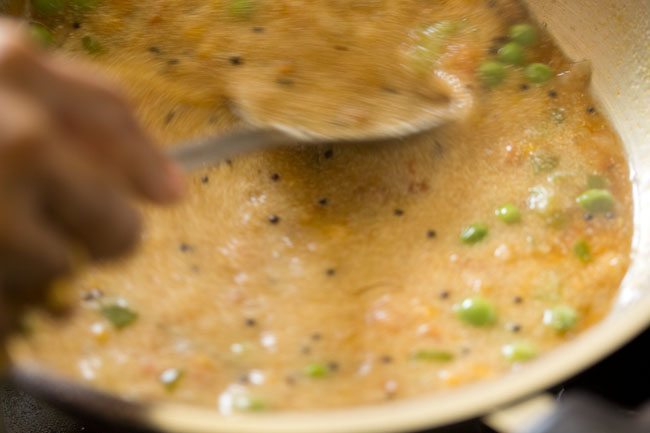

21. Now, add the next batch and then stir again very well.
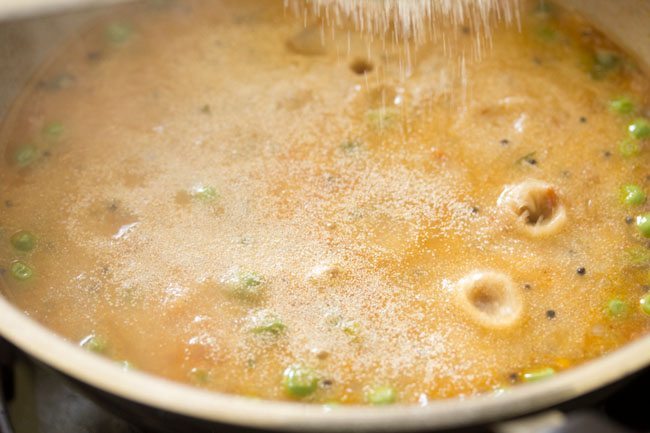

22. Finish off the roasted rava this way and mix very well.
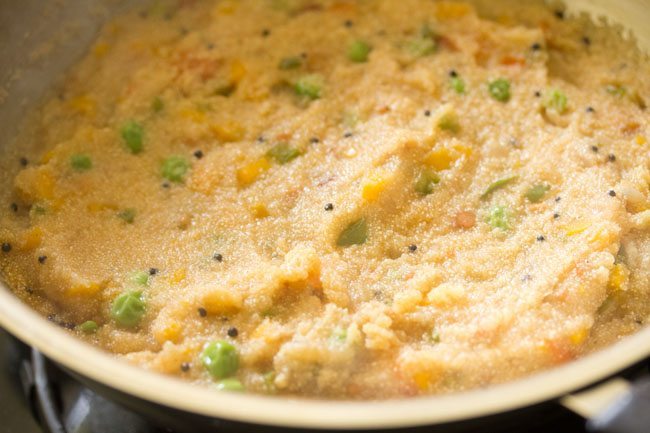

23. Then, cover the pan with a lid and cook on low heat for 3 to 4 minutes.
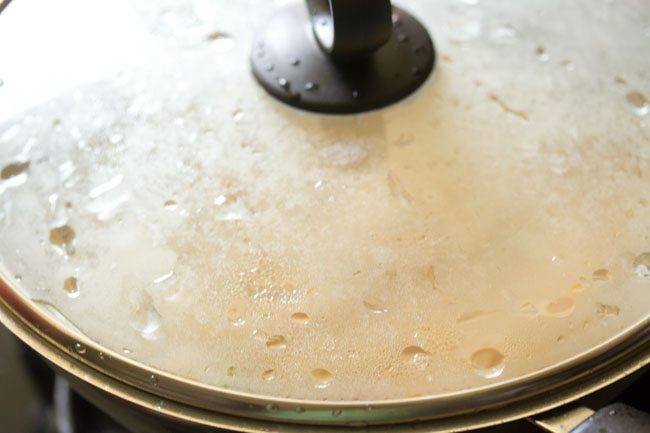

24. Open the lid
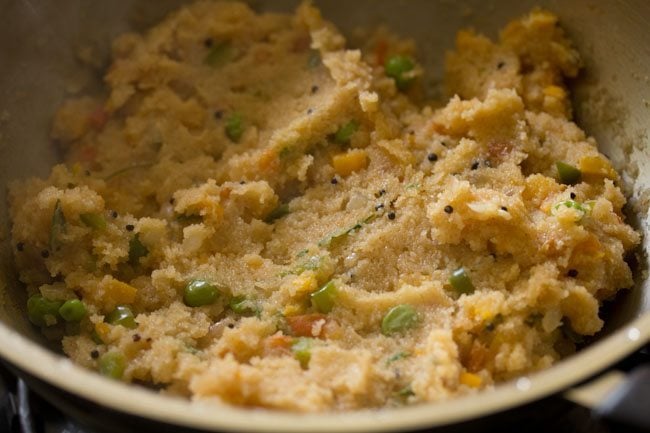

25. Then, add 2 tablespoons ghee.
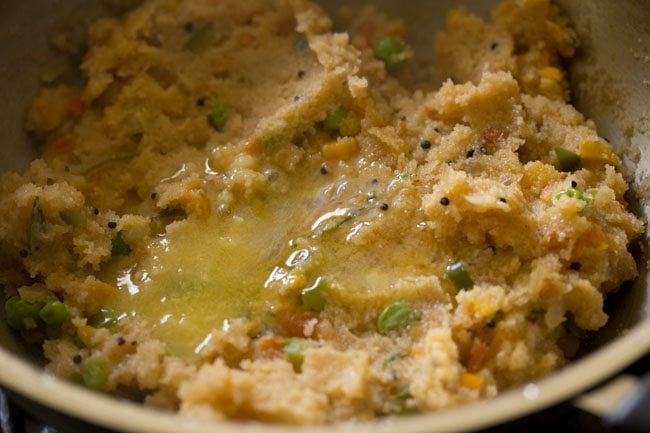

26. Also, add 2 to 3 tablespoons chopped coriander leaves.
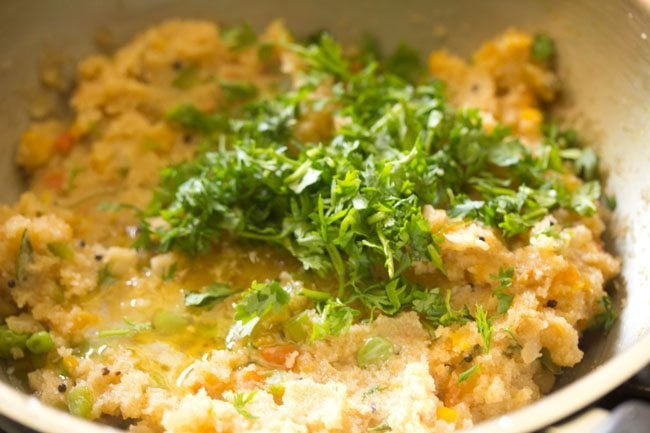

27. Mix very well, so that the ghee is mixed evenly in the Khara Bath. Lastly, add 10 to 12 fried cashews. Mix again. Keep aside. You can also place this savory mixture in small to medium steel bowls or in small to medium tart moulds and let them become warm. Once warm, then unmold and serve with Kesari Bath.
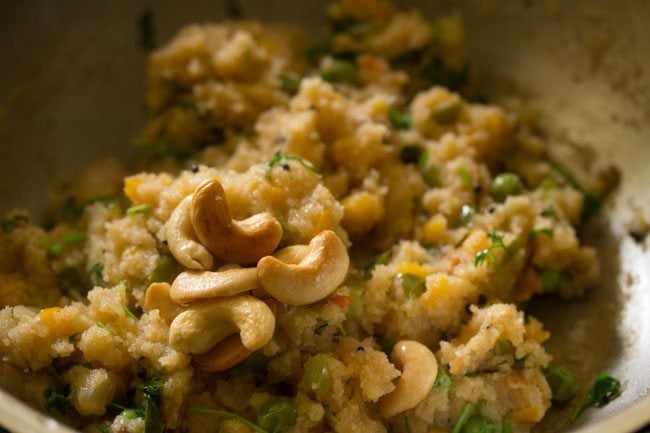

Making Kesari Bath
28. In another thick bottomed pan or kadai, take 1.5 cups water. Add ⅓ cup sugar (60 grams). You can also add ½ cup sugar for a more sweet taste. Keep the pan on low heat and stir very well, so that the sugar dissolves.
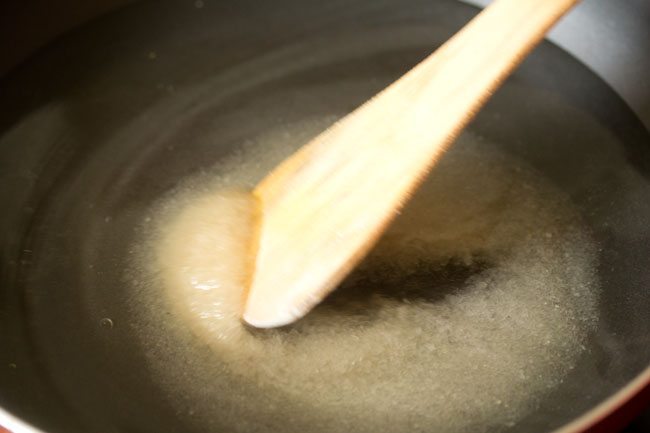

29. Add ½ tablespoon raisins and a pinch of saffron strands. I have added raisins in the sugar solution and they do soften up while cooking. If you want, you can even fry the raisins with cashews. Add 1 to 2 drops of natural food color extract, if using or else skip it. Mix very well. Here I have used an orange color natural extract.
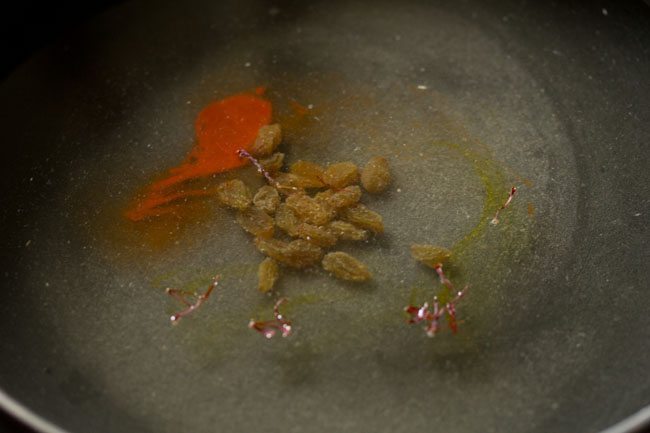

30. Mix very well.
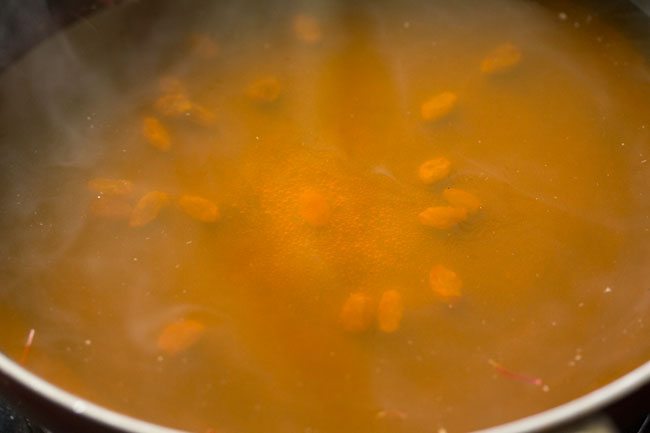

31. On low-medium heat, bring this sugar solution to a boil.
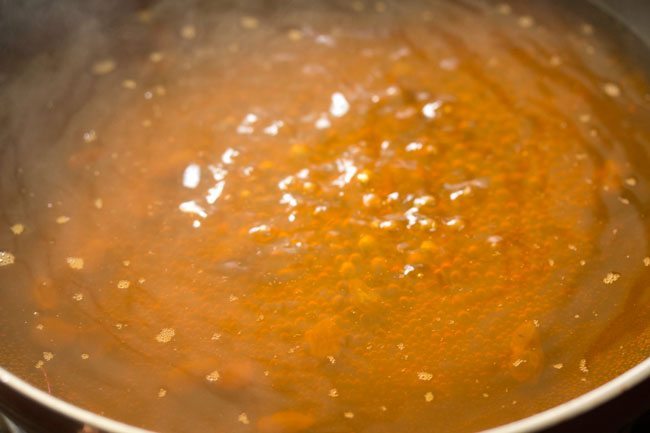

32. When it comes to a boil, lower the heat. Add the roasted rava in 2 to 3 batches. First add one batch
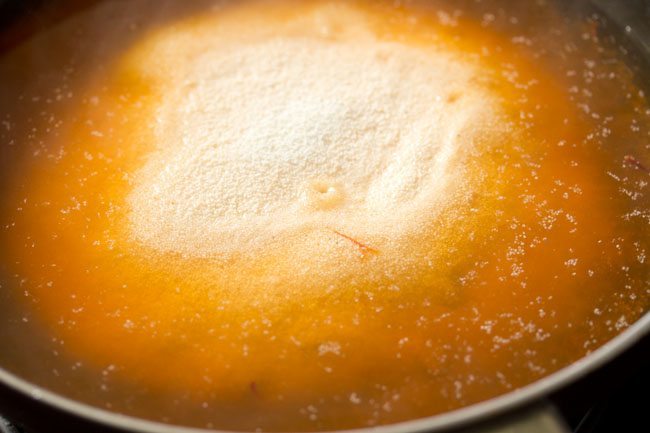

33. Then, quickly stir so that no lumps are formed.
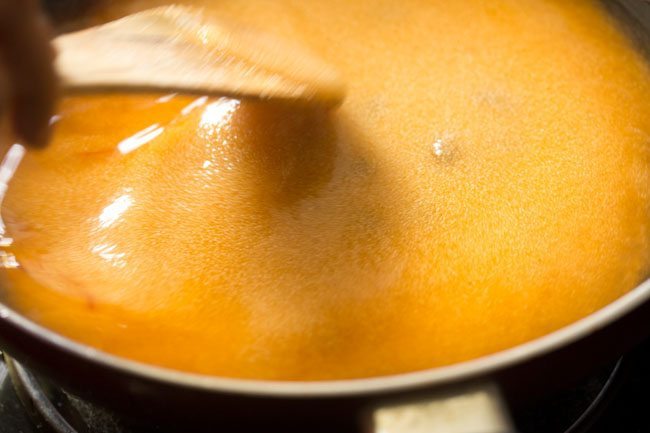

34. Continue to add the remaining batches of rava this way and mix very well.
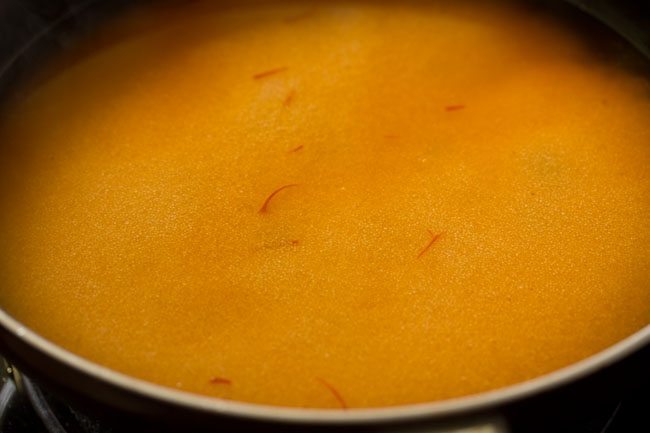

35. Add 2 to 3 tablespoons ghee.
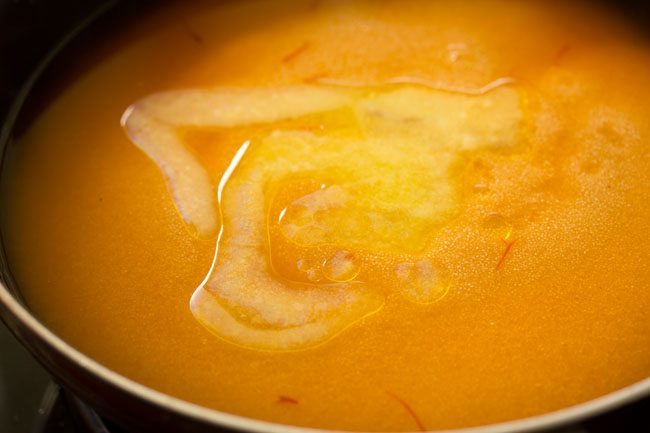

36. Add ¼ teaspoon cardamom powder.
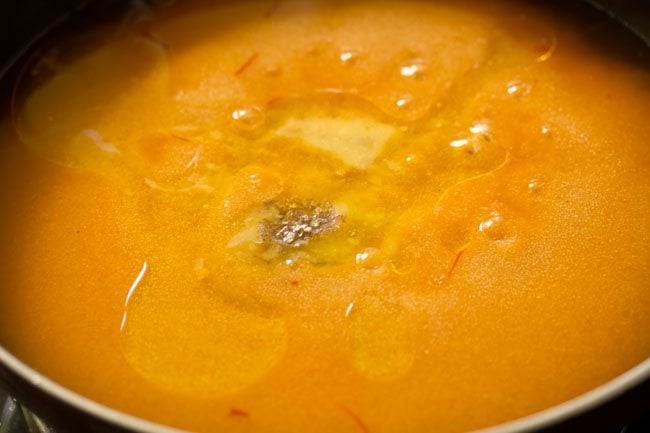

37. Mix very well, so that the ghee is distributed evenly in the Kesari Bath.
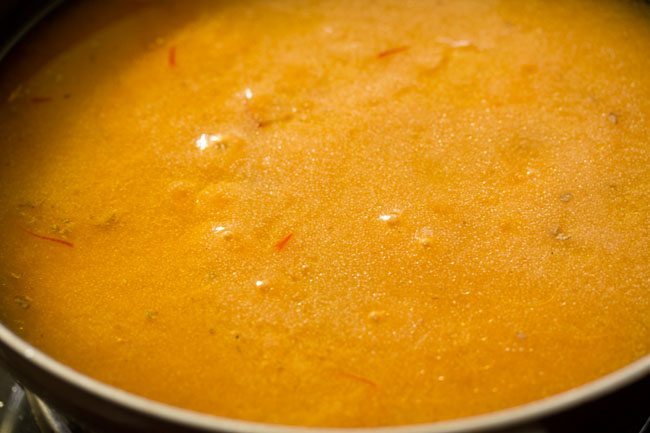

38. Cover the pan and on low heat or sim, let the mixture cook for 3 to 4 minutes.
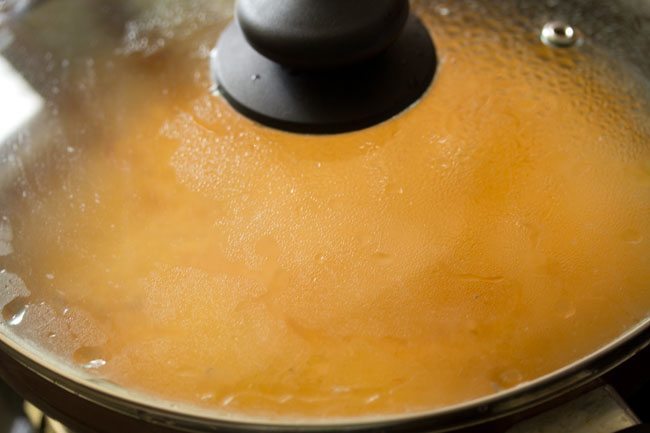

39. The rava will absorb the water and get done. The ghee will also be absorbed and the mixture will also thicken. You should not see any tiny whitish or creamish specks on the rava. If you see, this means that the rava is still not cooked well.
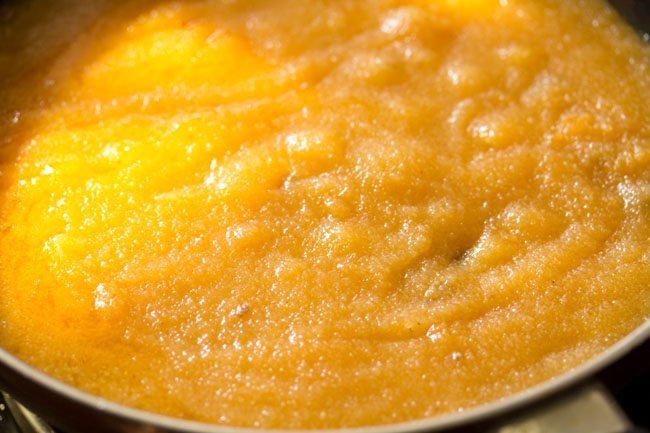

40. Once the rava is cooked well, add the fried cashews and mix well.
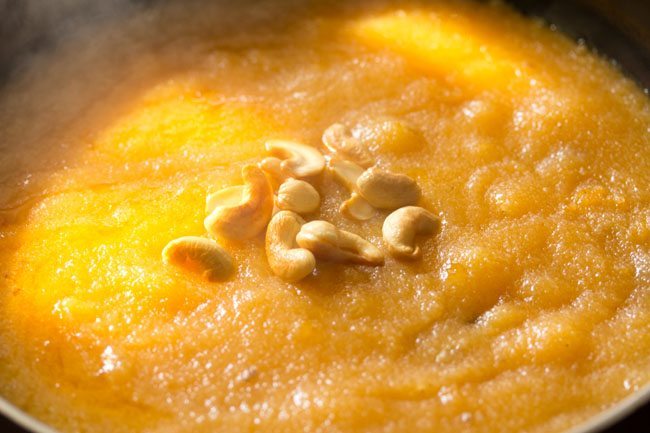

41. Serve both Khara Bath and Kesari Bath together hot or warm, along with coconut chutney. You can also pour the Kesari Bath in small to medium steel bowls or in small to medium tart moulds and let them become warm. Once warm, then unmold and serve.
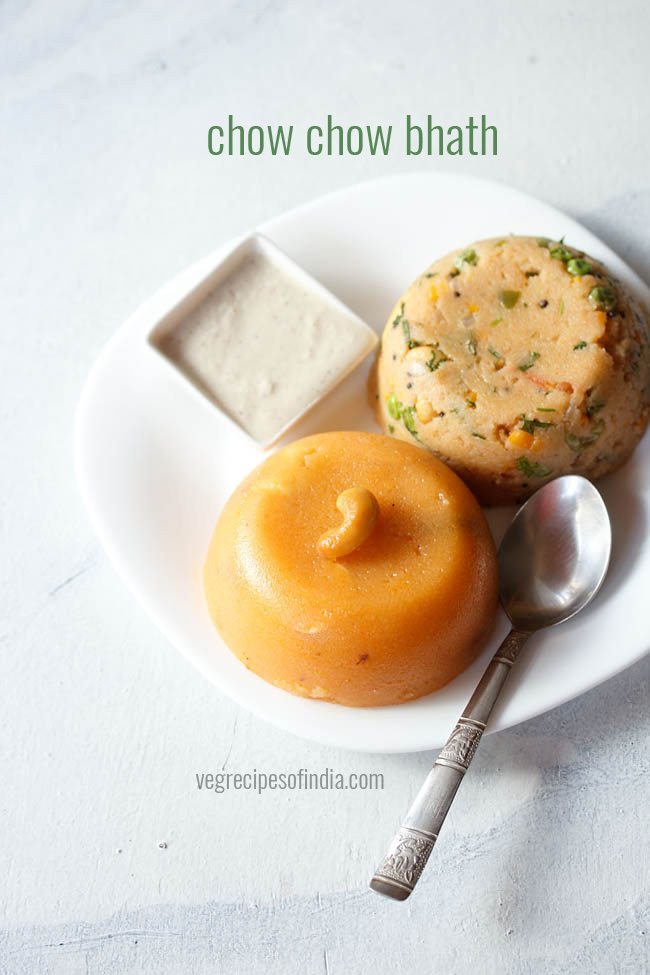

Expert Tips
- You can skip using the vangi bath masala powder, if you don’t have it. Add ¼ to ½ teaspoon red chili powder instead.
- Even if using the vangi bath masala powder, for a spicier taste, you can add the red chili powder. Or increase the quantity of vangi bath masala powder to 2 teaspoons.
- In the Khara Bath, you can also add 2 tablespoons of finely chopped French beans with the rest of the vegetables.
- For the sweet kesari bath, you can also fry the raisins along with the cashews instead of adding them in the sugar solution.
- You can make the kesari bath without adding the natural food color extract as well.
- While cooking the rava in the ghee for the sweet kesari, there should not be any tiny creamish or whitish specks in the rava. If there are, it means the rava is still not cooked well.
More Rava Recipes To Try!
Breakfast Recipes
Breakfast Recipes
Breakfast Recipes
Breakfast Recipes
Please be sure to rate the recipe in the recipe card or leave a comment below if you have made it. For more vegetarian inspirations, Sign Up for my emails or follow me on Instagram, Youtube, Facebook, Pinterest or Twitter.
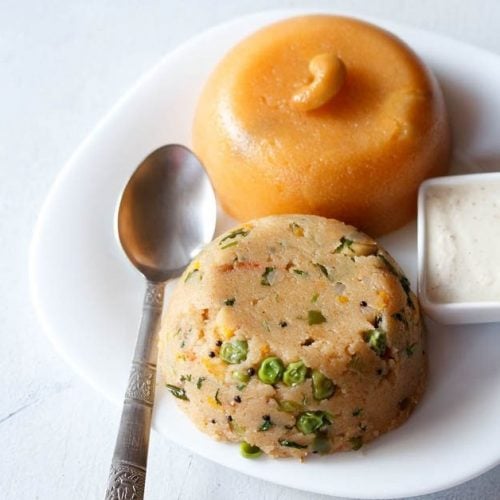

Chow Chow Bath
Chow chow bath is a savory-sweet breakfast consisting of rava bath and kesari bath.
Prep Time 15 minutes
Cook Time 30 minutes
Total Time 45 minutes
for preparing rava kesari bath
Prevent your screen from going dark while making the recipe
roasting rava
Heat a pan or kadai first. Add the 1 cup rava or cream of wheat (fine variety).
Begin to roast the rava. Stir often while roasting the rava. The rava or sooji grains should become fragrant and start to look dry, separate and crisp. Don’t brown the rava.
Roasting takes about 5 to 6 minutes on a low flame. Then switch off the flame. Once the rava becomes fragrant and starts to look dry and crisp, then switch off the flame and add the roasted rava in a plate and keep aside.
Take 1/2 cup of the roasted rava and keep aside. Half of the rava will be added in savory khara bhath and the other half in sweet kesari bhath.
frying cashews
In the same pan, heat 1 tablespoon ghee or oil. Add 20 to 22 cashews.
Stirring them often on a low to medium flame fry till they get golden. Keep aside.
preparing rava bath
Lower the flame and in the same pan, add 1/2 teaspoon mustard seeds, 1/2 teaspoon chana dal and 1/2 teaspoon urad dal.
On a low flame saute the lentils and mustard seeds, till the chana dal and urad dal gets golden. The mustard seeds will also crackle by then.
Next add 3 tablespoons finely chopped onions. On a low flame, saute for a minute.
Then add 3 tablespoons finely chopped capsicum, 3 tablespoons finely chopped carrot, 3 tablespoons finely chopped tomatoes and 2 tablespoons green peas.
Mix very well and add 7 to 8 curry leaves.
Season with 1/2 teaspoon sugar and salt as required.
Then add 1 teaspoon vangi bhaat masala. Mix very well.
Now add 1.5 cups water. Mix very well. Bring the water to boil at medium flame.
When the water comes to a boil, reduce the flame to a low. Then add the roasted rava in two to three batches.
As soon as you add first batch, stir very well. So that lumps are not formed.
This way add in batches. Stir very well after adding each batch.
Cover pan with a lid and cook on a low flame for 3 to 4 minutes.
Open the lid and then add 2 tablespoons ghee. Also add 2 to 3 tablespoon chopped coriander leaves.
Mix very well, so that the ghee is mixed evenly with the khara bhath.
Lastly add 10 to 12 fried cashews. Mix again.
Serve mtr style rava bath with some slices of lemon and coconut chutney.
preparing kesari bath
In another thick bottomed pan or kadai, take 1.5 cups water.
Add 1/3 cup sugar (60 grams). You can also add 1/2 cup sugar for a more sweet taste.
Keep the pan on a low flame and stir very well, so that the sugar dissolves.
Add raisins and a pinch of saffron strands. I have added raisins in the sugar solution and they do soften up while cooking. If you want you can even fry the raisins with cashews.
Add 1 to 2 drops of natural food color extract if using or else skip it. Mix very well.
On a low-medium flame bring this sugar solution to a boil.
When it comes to a boil, then lower the flame. Add the roasted rava in 2 to 3 batches. First add one batch and quickly stir so that no lumps are formed. Continue to add the remaining batch of rava and mix very well.
Add 2 to 3 tablespoons ghee & 1/4 teaspoon cardamom powder.
Mix very well, so that the ghee is distributed evenly in the kesari bhath.
Cover the pan and on a low flame or sim let the mixture cook.
Cook for 3 to 4 minutes.
The rava will absorb all the water and cook. The mixture will also thicken. You should not see any whitish or creamish tiny specks on the rava. If you see then this means that the rava is still not cooked well. Once the rava is cooked well then add the remaining fried cashews.
Mix very well.
Serve kesari bath hot or warm. You can also pour the kesari bath mixture in small to medium steel bowls or in small to medium tart moulds and let them become warm. Once warm then unmold and serve.
preparing coconut chutney
– skip vangi bhath masala powder if you do not have it. You can add 1/4 to 1/2 teaspoon red chilli powder instead.
– if using vangi bhath masala powder, then too for a spicy taste you can add 1/4 to 1/2 teaspoon red chilli powder.
– you can add 2 teaspoons vangi bhath masala powder also.
– 2 tablespoons of finely chopped french beans can also be added with the rest of the veggies.
This Chow Chow Bath recipe from the archives was first published in January 2016. It has been updated and republished in April 2024.
[ad_2]


